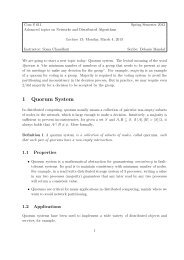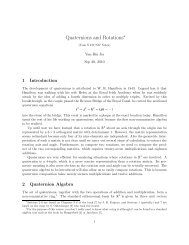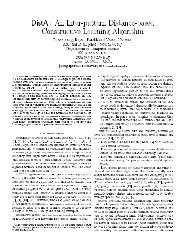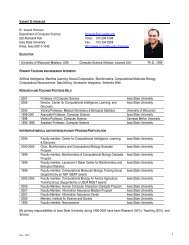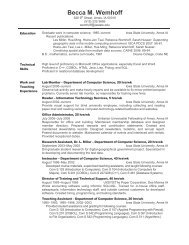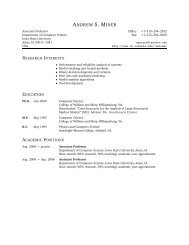Geocasting in Mobile Ad Hoc Networks: Location-Based ... - CiteSeerX
Geocasting in Mobile Ad Hoc Networks: Location-Based ... - CiteSeerX
Geocasting in Mobile Ad Hoc Networks: Location-Based ... - CiteSeerX
You also want an ePaper? Increase the reach of your titles
YUMPU automatically turns print PDFs into web optimized ePapers that Google loves.
future work.<br />
2 Related Work<br />
Multicast<strong>in</strong>g <strong>in</strong> mobile ad hoc networks is a relatively<br />
unexplored research area, when compared to the area of unicast<br />
rout<strong>in</strong>g for MANET [22]. However, recently, several<br />
protocols for multicast<strong>in</strong>g <strong>in</strong> MANET environments have<br />
been proposed [8, 7, 14, 23]. Reference [8] adapts fixed<br />
network multicast approaches (PIM Sparce Mode) to the<br />
MANET and proposes the Shared-Tree Wireless Network<br />
Multicast (ST-WIM) protocol. <strong>Ad</strong>hoc Multicast Rout<strong>in</strong>g<br />
(AMRoute) protocol [7] and Lightweight <strong>Ad</strong>aptive Multicast<br />
(LAM) protocol [14] are some other protocols for<br />
MANET multicast rout<strong>in</strong>g. Both algorithms may be categorized<br />
as tree-based approaches, as a group-shared forward<strong>in</strong>g<br />
tree is created and ma<strong>in</strong>ta<strong>in</strong>ed <strong>in</strong> LAM and usermulticast<br />
trees are exploited <strong>in</strong> AMRoute with dynamic<br />
cores. In the <strong>Ad</strong> <strong>Hoc</strong> Multicast Rout<strong>in</strong>g protocol utiliz<strong>in</strong>g<br />
Increas<strong>in</strong>g id-numbers (AMRIS)[23], a shared delivery tree<br />
rooted at a special node is constructed and ma<strong>in</strong>ta<strong>in</strong>ed.<br />
The closest work to ours is GeoCast by Navas and<br />
Imiel<strong>in</strong>ski [13, 19]. In their scheme also, multicast group<br />
members are (implicitly) def<strong>in</strong>ed as all nodes with<strong>in</strong> a<br />
certa<strong>in</strong> region. To support location-dependent services<br />
such as geographically-targeted advertis<strong>in</strong>g, they suggested<br />
three methods: geo-rout<strong>in</strong>g with location aware routers,<br />
geo-multicast<strong>in</strong>g modify<strong>in</strong>g IP multicast, and an application<br />
layer solution us<strong>in</strong>g extended Doma<strong>in</strong> Name Service<br />
(DNS). This paper considers geocast<strong>in</strong>g <strong>in</strong> mobile ad hoc<br />
networks.<br />
The algorithms proposed <strong>in</strong> this paper are based upon<br />
a multicast flood<strong>in</strong>g approach and the basic idea of the algorithms<br />
is derived from protocols we previously proposed<br />
for rout<strong>in</strong>g <strong>in</strong> mobile ad hoc networks [15]. In [15], we<br />
presented an approach to utilize location <strong>in</strong>formation to improve<br />
performance of rout<strong>in</strong>g protocols <strong>in</strong> MANET. To decrease<br />
overhead of route discovery by limit<strong>in</strong>g the search<br />
space for a desired route, the schemes use physical location<br />
<strong>in</strong>formation for mobile hosts, which may be obta<strong>in</strong>ed us<strong>in</strong>g<br />
the global position<strong>in</strong>g system (GPS) [1]. Similar ideas have<br />
been applied to develop selective pag<strong>in</strong>g for cellular PCS<br />
(Personal Communication Service) networks [3]. In selective<br />
pag<strong>in</strong>g, the system pages a selected subset of cells close<br />
to the last reported location of a mobile host. This allows<br />
the location track<strong>in</strong>g cost to be decreased.<br />
Metricom is another example of packet radio systems us<strong>in</strong>g<br />
location <strong>in</strong>formation for the rout<strong>in</strong>g purpose [18]. In<br />
the Metricom network <strong>in</strong>frastructure, location of fixed base<br />
stations is determ<strong>in</strong>ed us<strong>in</strong>g a GPS receiver at the time of<br />
<strong>in</strong>stallation. Metricom uses a geographically based rout<strong>in</strong>g<br />
scheme to deliver packets between base stations. A packet<br />
is forwarded one hop closer to its f<strong>in</strong>al dest<strong>in</strong>ation by com-<br />
2<br />
par<strong>in</strong>g the location of packet’s dest<strong>in</strong>ation with the location<br />
of the node currently hold<strong>in</strong>g the packet. Recently, another<br />
way of us<strong>in</strong>g location <strong>in</strong>formation for rout<strong>in</strong>g protocol<br />
has been proposed <strong>in</strong> [6]. Their protocol, named DREAM,<br />
ma<strong>in</strong>ta<strong>in</strong>s location <strong>in</strong>formation of each node <strong>in</strong> rout<strong>in</strong>g tables<br />
and sends data messages <strong>in</strong> a direction computed based<br />
on these rout<strong>in</strong>g (location) tables. To ma<strong>in</strong>ta<strong>in</strong> the location<br />
table accurately, each node periodically broadcasts a control<br />
packet conta<strong>in</strong><strong>in</strong>g its own coord<strong>in</strong>ates, with the frequency of<br />
dissem<strong>in</strong>ation computed as a function of the node’s mobility<br />
and the distance separat<strong>in</strong>g two nodes (called the distance<br />
effect).<br />
3 <strong>Location</strong>-<strong>Based</strong> Multicast Protocols<br />
Two approaches may be used to implement locationbased<br />
multicast:<br />
Ma<strong>in</strong>ta<strong>in</strong> a multicast tree, such that all nodes with<strong>in</strong><br />
the multicast region at any time belong to the multicast<br />
tree. The tree would need to be updated whenever<br />
nodes enter or leave the multicast region.<br />
Do not ma<strong>in</strong>ta<strong>in</strong> a multicast tree. In this case, the multicast<br />
may be performed us<strong>in</strong>g some sort of “flood<strong>in</strong>g”<br />
scheme. As elaborated below, this is the approach<br />
taken <strong>in</strong> this paper.<br />
3.1 Multicast Flood<strong>in</strong>g<br />
Flood<strong>in</strong>g is probably the simplest multicast rout<strong>in</strong>g algorithm<br />
[12]. The flood<strong>in</strong>g algorithm can be used to deliver<br />
packets to nodes with<strong>in</strong> a location-based multicast group.<br />
The multicast flood<strong>in</strong>g algorithm can be implemented as<br />
follows: Assume that a node S needs to send a packet to<br />
a specific multicast region, a circle <strong>in</strong> Figure 1. Node S<br />
broadcasts the multicast packet to all its neighbors 2 – hereafter,<br />
node S will be referred to as the sender and nodes D,<br />
F, and G as the multicast group members (note that <strong>in</strong> Figure<br />
1 all nodes present <strong>in</strong> the specified multicast region are,<br />
by def<strong>in</strong>ition, multicast group members). A node, say B or<br />
C, on receiv<strong>in</strong>g the packet, compares the specified region’s<br />
coord<strong>in</strong>ates with its own location. (We assume that all hosts<br />
are able to determ<strong>in</strong>e their own location us<strong>in</strong>g GPS.) If the<br />
location of B is with<strong>in</strong> the specified multicast region, node<br />
B will accept the packet. Node B will also broadcast the<br />
packet to its neighbors, if it has not received the packet previously<br />
(repeated reception of a packet is detected us<strong>in</strong>g sequence<br />
numbers). If node B is located outside the multicast<br />
region and the packet was not received previously, it just<br />
broadcasts the packet to its neighbors. In Figure 1, when<br />
2 Two nodes are said to be neighbors if they can communicate with each<br />
other over a wireless l<strong>in</strong>k.



